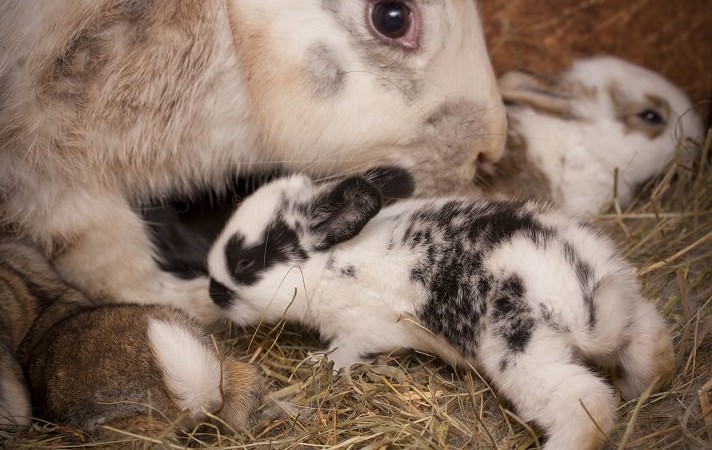

Unless the mother rabbit is known to be dead, there is a good chance that she is feeding her babies, even if she seems to be ignoring them. A mother rabbit does not constantly tend to her babies the way a mother carnivore does. Rabbit mamas feed their babies only twice per day, and then leave them alone. This is normal and natural: in the wild, a mother rabbit not in the process of feeding her off spring stays as far away from the nest as possible to avoid attracting predators to her babies.
If the mother rabbit seems to be “ignoring” her litter, check their condition before you interfere. If the babies’ tummies are round and full-looking (you sometimes can see a whitish patch where the milk-filled stomach shows through the thin skin of the belly), they are warm, their skin is a healthy, dark pink, and not overly wrinkled, and they are sleeping calmly in the nest, then mama is feeding them. If the babies are very wrinkled, cold, bluish in color, have shrunken bellies, and perhaps are even crawling around looking for mama (instead of nest-sleeping, as a well-fed baby should), then you may have to intervene.
Before handling the babies, wash your hands well with disinfectant soap and hot water. Your hands are covered with bacteria, no matter how clean they may seem, and these can be dangerous to babies whose immune systems are not yet mature enough to control bacterial growth, should harmful microbes be ingested. Once they’re clean, rub your hands in a bit of clean, fresh hay and on mama’s fur to scent your hands.
If the Rabbit has been separated from the babies for more than 24 hours, and refuses to feed them, you can try to gently, but firmly hold her over the babies until they can get a meal. Stroke the rabbit, talk to her gently and love her, making her feel secure. After the first feeding, you probably won’t have to do this again. She will take care of the babies on her own.
If the mother rabbit is very ill, dead, or exhibiting aggression towards her babies, you may have to remove them and feed them without her help. Before you take on this formidable task, consider the following:
Did the babies get any mother’s milk? If not, you’ll have to provide the babies with a special, immunoglobin-rich substance called colostrum. For the first few days of lactation, a mother mammal produces colostrum, which contains antibodies that help destroy foreign bacteria. Without a colostrum “starter”, the babies have a lower chance of survival.
If the babies really are orphans or have been abandoned by their mother, here’s a protocol that’s been successful for us.
Keep the babies in a warm (about 75o – 78o Farenheit), quiet place in a nest similar to the one described above. (Bunny fur is the best lining, but clean cotton wadding will do as a substitute. Just be sure the babies do not get tangled in it.) DO NOT use an electric heating pad. Two or more babies usually are able to snuggle and keep each other warm if they have a good, padded nest. If there’s only one baby, a warm water bottle wrapped in a soft towel can provide an excellent artificial heat source, but be sure the baby can crawl away from the bottle if it feels too warm.
The nest box should be at ground level, in a room where small children and pets are not allowed (at least until the babies are eating solid food and out of the nest). For the first few days, keep the room relatively dimly lit and quiet.
Weaning rabbits
A domestic rabbit feeds her babies for about 8 weeks, gradually decreasing the frequency of feedings until they lose interest. Your baby bunnies will start to nibble on pellets and solid food at about the age of two to three weeks, but this does NOT mean they are ready to be weaned. In fact, it’s even more important that you continue feeding colostrum-enhanced formula to help control the growth of potentially harmful pathogens as the babies introduce new bacteria into their systems.
If the babies still beg for nursing by the age of six – eight weeks, you can begin to dilute the formula with clean drinking water. Start with 25% water to 75% formula, and gradually decrease the percentage of milk until the babies lose interest. It’s less traumatic for you and the babies to gradually wean them this way.
 Contact Jaguza Support
Contact Jaguza Support